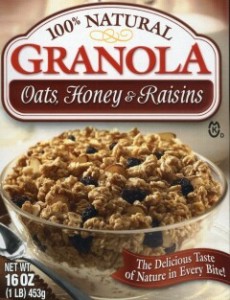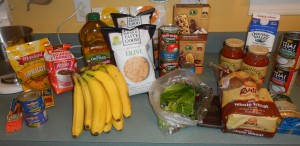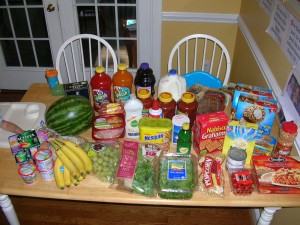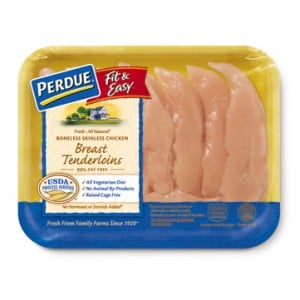Probably the number one thing I have had to clarify since making up the word “poorganic” is what it does and DOESN’T mean. In this final Eating Poorganically rerun from August 2011, I explain some of the criteria I use to determine whether or not food is “poorganic.” For the most part, these flexible criteria have lasted for our whole year of eating poorganically.
****************************************
Before we get TOO much further into this fun world, I just want to clarify a few definitions as I understand them so far from my research. I’m also, finally, going to give you the ACTUAL definition for Eating Poorganically. I’m sure as I continue this process my opinions may evolve. As always, I rely on my “organic friends” to comment and fill in the gaps of my explanation. Check the links to see a more complete bit of info.
 ORGANIC: USDA certified organic products are verified by the USDA- FDA as being without pesticides, antibiotics, hormones or any genetic modification. A product may be labeled as “100% organic”, “organic” (95% organic ingredients), or “contains organic ingredients”.
ORGANIC: USDA certified organic products are verified by the USDA- FDA as being without pesticides, antibiotics, hormones or any genetic modification. A product may be labeled as “100% organic”, “organic” (95% organic ingredients), or “contains organic ingredients”.
A few thoughts from me . . . The problem with this labeling is that A LOT of food that actually is organic is not certified because the process is tricky, expensive, and time consuming. Secondly, in some cases the labeling is stupid because organic fish, for example, has to be farm raised so its food can be monitored. This is counter-intuitive to the idea of preferring “wild-caught fish” which may have eaten anything in the ocean.
The advocates for organic foods seem to both love and hate the labeling system. They want all foods labeled to be completely clear what is in them; however, some purists don’t even think the requirements of the USDA Organic checker-people are strict enough, so they don’t trust the label anyway. It’s like the labelers are danged if they do and danged if they don’t. (C’mon people, seriously? Did you read too much Charlotte’s Web? I think ya’ did. Eat the pig already.)
 In the case of produce, however, I did learn one helpful trick. Technically, the PLU sticker on the fruit for conventionally raised fruit should be FOUR digits. (Conventional produce can use pesticides and waxes.) Genetically modified produce should have a PLU sticker with FIVE digits the first of which is 8. Organic produce has a FIVE digit PLU, the first number of which is 9.
In the case of produce, however, I did learn one helpful trick. Technically, the PLU sticker on the fruit for conventionally raised fruit should be FOUR digits. (Conventional produce can use pesticides and waxes.) Genetically modified produce should have a PLU sticker with FIVE digits the first of which is 8. Organic produce has a FIVE digit PLU, the first number of which is 9.

NATURAL: Basically, the word “natural” could mean that something is in its natural state OR it could simply mean naturally derived junk is in the product. Apparently there is not oversight for the use of the term. Manufacturers can call products “natural” if the products in it are derived from nature. Practically EVERYTHING (including weed, heroin, and cocaine) is derived from nature. In fact “nature” seems to include just about all of the vast amount of products (high fructose corn syrup, malodextrin, hydrogenated oils, etc.) not made by nuclear fusion. Also, genetically modified crops and their derivatives can also be called natural.
A few of my thoughts: This is not to say that a NATURAL is bad; it is just kind of meaningless. It is like a village midwife with no credential. She could be awesome and helpful and knowledgeable; she could be a terrible, squeamish rookie. There’s no way to know without just letting her atcha’. 😉 Similarly, in the case of these foods, yo u really need to look at the ingredients and think through whether it is something like “All Natural Tomatoes” with ingredients “Tomatoes, salt” or “All Natural Tortilla Chips” with a list of ingredients as long as your arm, half of which are unpronounceable.
u really need to look at the ingredients and think through whether it is something like “All Natural Tomatoes” with ingredients “Tomatoes, salt” or “All Natural Tortilla Chips” with a list of ingredients as long as your arm, half of which are unpronounceable.

REAL: Real food is food that is as close to its natural state as possible. It excludes processed foods, artificial foods, GMO foods, and, to some degree, non-organic foods. However, Real Foodies, like my girl, Lisa at 100 Days of Real Food (she doesn’t know she’s my girl, but she is) don’t even buy things like organic granola bars because they are still heavily processed, just with organic ingredients. She doesn’t use ANY refined flours or sugars or any foods with more than five ingredients. If it requires more than five ingredients, she makes it from scratch, using the requisite “real foods.” She grinds her own wheat and makes cake with whole wheat flour. (I’m sorry folks; that is just wrong. I love The Pioneer Woman too much for that.)
My thoughts on this: I think avoiding processed foods is good and she has definitely created some awesome menus; however, I’m not ready to give up sugar and start grinding my own wheat. I think that the five ingredient rule is a good one though. I have realized that we ate more processed food than I realized once I considered that many breads and cereals are actually “processed.” Duh.

Eating Poorganically Definition: After my initial research, my motto is “Consider the Source.” This applies both to food and information. Here’s a few guidelines (not rules) that I’m following for now.
1. For fruits and vegetables, I’m going to focus on buying locally and washing thoroughly, while avoiding genetically modified produce. If an item is on the “Dirty Dozen,” I may consider buying the organic option OR just try to do a better job of washing to remove pesticides. There is VERY conflicting evidence about the residual presence of pesticides on plants AND about how damaging those may or may not be, so I’m considering the source with that information as well.
2. For meat, eggs, and milk, I’m going to try to buy organic or from a reliable source that is free of genetically modified feeds, hormones, and antibiotics. At this point, it seems reasonable to think these things should not be in our food supply although, in point of fact, this also is NOT proven. While purists will tell you not to trust the labels of manufacturers like Perdue, who are not organic but make claims like “all vegetarian feed,” “no animal by-products,” “and cage-free,” I will probably trust these claims UNTIL they prove themselves untrustworthy to my knowledge or experience. I refuse to be swayed by hyped-up conspiracy theories or documentaries. It is just not my way.
Incidentally, I did notice that there is a label on ALL chicken that says the use of steroids and hormones are prohibited in poultry by the USDA. Additionally, many non-organic milks indicate that they do not come from cows who are given hormones (rBst). That is to say, Eating Poorganically means that you can be a label reader, a smart shopper, and get around buying exclusively organic. (Purist Organics tend to believe that you are “guilty” until certified organic, but that is not the EP way.) Just consider your source.
3. For the remaining foods, I’m going to follow the five ingredient Real Food rule OR TRY to buy organically. When I’m not buying organic items, I’m going to try to do a better job of avoiding artificial ingredients, refined grains and sugars, preservatives, and ingredients that could be derived from unlabeled genetically modified crops (like high fructose corn syrup or sugar, which I learned is often derived from GM sugar beets unless it says 100% cane sugar). I really have to read labels for this, but there are many great options for foods that are perfectly within these criteria that are not necessarily organic.
4. (Rule 4 is my favorite.) However . . . . .when I’m out of my house, I can eat whatever I want or whatever I am served, with a smile. I can eat any food someone gives me with love. Eating Poorganically is about being healthy, making good choices, and teaching my kids to do the same. I don’t want this to be about legalism, obsession, exclusion, or guilt. So while I hope that we will make good choices at home and away from home, the point is to make realistic choices.
For example, when my mom showed up at my door yesterday with Chocolate Truffle Cheesecake, did I say, “I’m sorry mom; is this organic?” No, I did not. Did I feel bad eating it? No, I did not. I felt awesome. Did I feel bad watching Anika eat it? No, I did not. (Well, actually, I kind of regretted giving her such a big piece because it made less for me, but other than that, I did not.) I considered the source: Mom, the best Cheesecake Maker and baker on the planet. Nuff said.

5. We are going to eat any and all processed or other food that is currently in our house till it is gone. In my opinion, wasting is worse than being poisoned by pesticides or genetically modified by Monsanto. You can throw out all of your ketchup, mayonnaise, and Frosted Mini Wheats to start from scratch, but I am not doing that. If necessary, we will replace these items with smarter choices as we go.
6. I’m going to do all of that for $85-$100 a week. (Unless it was last week, when I didn’t. But starting NOW, I am.)
*******************************************
I will say that I did buckle on rule 5 a few months after this and throw away a boo-koodle of salad dressing because it had BOTH corn syrup and soybean oil. I haven’t missed it.
After this post I also added the terms “schmorganic,” and “uborganic” to our definitions to describe those who into a more relaxed camp, or the more extreme camp respectively. Are you an uborganic, a schmorganic, or a poorganic?
*********************************************
Final Summer of 7 post coming soon!


Thanks, great article I learned alot!